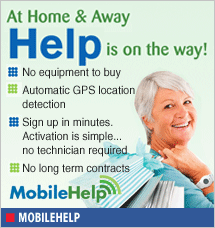Washington Watch
Technology Growing as One of Many Long-Term Care Options for Seniors

 While lawmakers on Capitol Hill stake out their political positions in advance of the next stage of the never-ending budget debate, a far-reaching set of spending cuts scheduled to go into effect at the beginning of March, one issue has fallen off the radar screen – long-term care – despite that millions of older Americans and their families are being forced to deal with it.
While lawmakers on Capitol Hill stake out their political positions in advance of the next stage of the never-ending budget debate, a far-reaching set of spending cuts scheduled to go into effect at the beginning of March, one issue has fallen off the radar screen – long-term care – despite that millions of older Americans and their families are being forced to deal with it.
Earlier this year, during the fiscal cliff fight, Congress repealed the Community Living Assistance Services and Supports (CLASS), which had previously been abandoned by the Obama administration because it wasn’t financially sustainable. In its place, lawmakers created a new national commission to develop a plan for better financing and delivery of long-term care services. But the commission’s recommendations, which are required in six months, do not require any congressional action, so little is expected to come of the effort.
Nonetheless, some progress is being made in efforts to help seniors cope with getting older as scores of new options flourish for seniors. Right now, about 10 million seniors currently rely on others for daily care – things like help getting dressed, preparing meals or taking medication. But those numbers are going to skyrocket as more of the nation’s 78 million baby boomers get older. Nearly 7 in 10 people will need some form of long-term care after turning 65, according to the Georgetown University Public Policy Institute.
While nursing homes remain the most intensive form of long-term care available because they offer round-the-clock medical supervision, the vast majority of seniors see nursing homes as a last resort and increasing numbers of seniors don’t want to go to a nursing home at all, preferring to stay in their own homes. If they can’t stay home, most prefer a place where they can get assistance in a place that feels like home. That is leading to a rise in community organizations, providing care for seniors living in their homes.
Nursing homes come with a big price tag – the average cost of a semi-private room last year was $81,000, according to a survey by insurance provider MetLife. A private room ran more than $90,500. Luckily, most seniors won’t need nursing home care. Studies show that only 5 percent of seniors will need five years or more in a nursing home.
What is growing dramatically is the need for home-care services that offer help with meals and household chores. Many seniors are finding another option, living with other seniors in boarding houses with on-site caretakers. But neither of these options are covered by Medicare, the government’s health care plan for seniors, or by private health insurance. That means this comes out of pocket for seniors and their family members.
Insurance policies for long-term care are available as well, but only about 5 percent of Americans have them. Most families don’t plan for long-term care because often the need comes unexpectedly and the costs are significant. Long term care policies typically run between $1,000 and $8,000 a year, depending on the policyholder’s age, health and other factors. So that rules out most seniors who live on fixed incomes.
Advocacy groups suggest that families discuss various options for long-term care and how to pay for them before they become necessary. But even if you pay for a long-term care policy, it may not cover what you need. A provision in many long-term care policies called “alternative plan of care” benefits – that people rely on to help ensure their coverage will meet their needs decades down the road – are intended to help provide coverage that isn’t spelled out in the policy but may emerge in the future, advocates suggest.
As Bonnie Burns, a policy specialist at California Health Advocates, a Medicare advocacy and education organization, told the Associated Press recently, long-term care policies that were sold 30 years ago, for example, didn’t cover care in an assisted living facility, even though such coverage is common now.
Long-term care insurance offers financial protection if a person needs help with daily tasks like eating or bathing. Policies typically cover care provided in different settings, whether it’s a nursing home, private home or an assisted living facility. People usually buy a policy that provides up to a specified daily dollar amount – say $150 – for between three and five years. Burns says that although alternative plan of care clauses can be beneficial, they are honored at the insurance company’s discretion. “It’s completely up to the company,” she says. “I’ve had situations where companies have refused to pay under that benefit.” Burns suggests the key question people need to ask is “What’s the long-term care landscape going to look like in 20 years?”
So what kinds of services are available and can technology help? Yes and absolutely. For most of us, the key is finding a way to stay in touch with a loved one who often is in another city or lives by themselves.
Medical Alert Systems: Among the least intrusive options to stay in touch with older folks who live by themselves are the “I’ve fallen and can’t get up” type of medical alert system. These help folks summon assistance in the event of an emergency. Services like Philips Lifeline (http://www.lifelinesys.com/content/home), Bay Alarm Medical (bayalarmmedical.com) and Life Alert (lifealert.net) consist of a necklace or wristband with an emergency button that rings a dispatcher who has access to the senior’s profile and medical history. Depending on the situation, the dispatcher will call a neighbor, family member or medical center. Those services tend to cost between $30 and $50 a month. Some companies also offer extra motion sensor technology that automatically contacts a dispatcher if it detects the user has fallen. At the recent Consumer Electronics Show in January in Las Vegas, Philips Lifeline launched a new mobile device called GoSafe, a personal emergency response system that combines the latest in fall-detection software, locating technology and two-way cellular voice communication.
Lowe’s, the home improvement retailer, is also expanding its basic, cloud-based Iris home monitoring efforts to help seniors and families, offering its new Iris Care system, which, among other tasks, sends out an email to family members when an older relative doesn’t get out of bed at the normal time, detecting the information with sensors and monitors. Seniors can also carry a $30 pendant, similar to other companies, which they can use to trip an alarm or reach emergency contacts in times of distress.
Adult Day Care: These programs tend to operate during business hours Monday through Friday, providing activities and meals for seniors, offering a break for over-stressed caregivers. There are more than 5,000 of these centers available in communities all over the United States. The average rate for adult day care last year was $70 a day or about $18,000 annually. Be aware that most of these facilities are licensed and certified by state and county governments. The National Adult Day Services Association http://www.nadsa.org/consumers/site-visit-checklist/ has a clearinghouse of information and most importantly, they recommend visiting potential centers and going through a checklist of options and amenities including door-to-door transportation and accessibility.
Home Visiting Services: For seniors who want to stay in their homes, visiting services can provide assistance with everything from preparing meals to physical therapy. The typical cost of a home care service last year, according to a recent Associated Press report was $20,800, at a rate of 20 hours per week. Most companies offer both homemaking services and medical assistance, which is usually billed at a higher rate. National companies like Visiting Angels (www.visitingangels.com/) and Home Instead (www.homeinstead.com), generally cost more than some local health care providers but they also provide pre-screening and background checks for all employees. Hiring a private caregiver can be less expensive, though you may have to do more work in terms of performing background checks and tax requirements since you are hiring them as an employer. Good starting points for information can be found at the U.S. administration of Aging’s Eldercare Locator (http://www.eldercare.gov), the National Association for Home Care, (http://www.nahc.org) or the Visiting Nurse Associations of America, (http://www.vnaa.org). Don’t forget to ask people you know for referrals and references.
Community Service Options: Health and supportive services provided by community service organizations around the country are exploding offering options for seniors to get services they need while living in their homes. Many offer seniors rides to medical appointments, help getting groceries, and assistance getting prescriptions, help around the house, health and wellness programs, support groups, activities and referrals to community service providers. Hundreds of these groups exist in nearly every community in the country, modeled on Boston’s famous Beacon Hill Village. To find a village in your community, see http://vtvnetwork.clubexpress.com/
(Also contributing to this column were the Associated Press, Kaiser Health News and Politico.)
Alan Schlein runs DeadlineOnline.com, an internet training and consulting firm. He is the author of the bestselling “Find It Online” books.
John Stinger Cartoon





























































